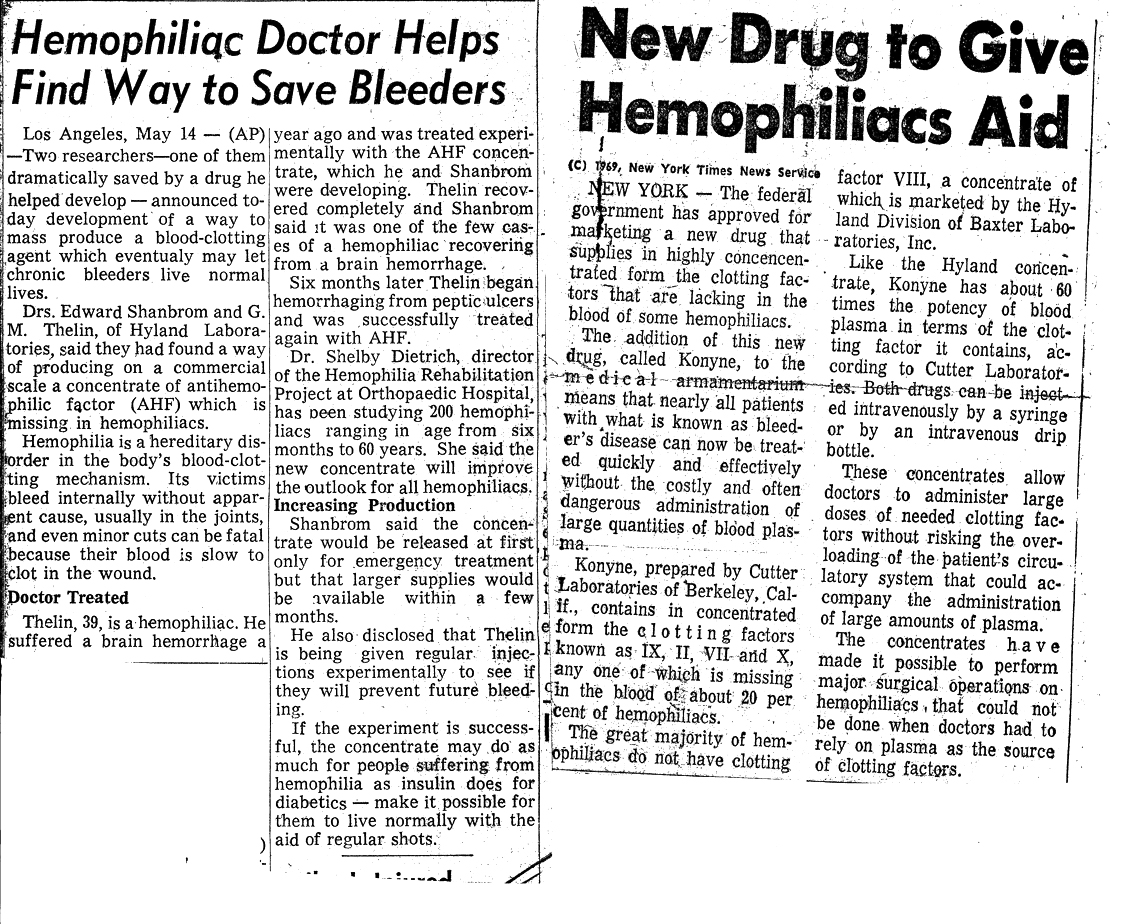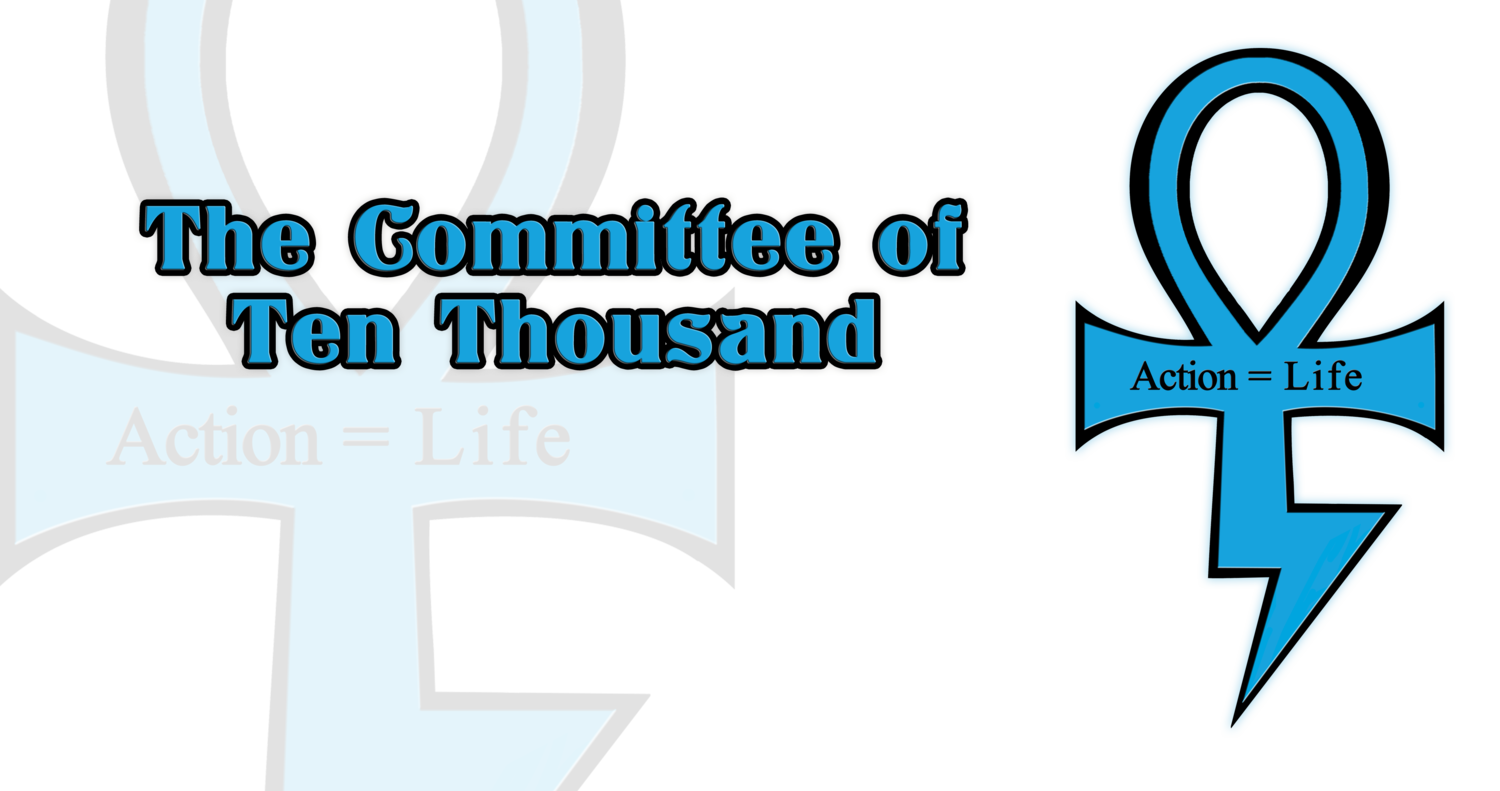Historical Record, Vol. 7
/ This installment of the "archive e-newsletter" includes an attachment containing two articles regarding the research behind and introduction of factor concentrates. The first article, "Hemophiliac Doctor Helps Find Way to Save Bleeders" is dated May 14th, 1966 and references Dr. Edward Shanbrom, a researcher with Hyland labs, and his collaboration with biochemist and hemophiliac, Murray Thelin, of the University of North Carolina at Chapel Hill.
This installment of the "archive e-newsletter" includes an attachment containing two articles regarding the research behind and introduction of factor concentrates. The first article, "Hemophiliac Doctor Helps Find Way to Save Bleeders" is dated May 14th, 1966 and references Dr. Edward Shanbrom, a researcher with Hyland labs, and his collaboration with biochemist and hemophiliac, Murray Thelin, of the University of North Carolina at Chapel Hill.
The second article, "New Drug to Give Hemophiliacs Aid", is dated 1969, and heralds the arrival of the new factor concentrates. I'm also including some biographical information about Dr. Ed Shanbrom and his role in the development of factor concentrates.
"In the late 1960s, a new and more concentrated form of Factor VIII was developed. Drs. Kenneth Brinkhous of the University of North Carolina and Edward Shanbrom of Hyland laboratories produced the Factor VIII concentrate by pooling hundreds-later thousands-of units of plasma. From these pools they made large quantities of cryo[precipitate]. Then they redissolved the cryo, treated it with chemicals, fitered it, and centrifuged it-all to produce a white crystalline powder of pure, highly concentrated Factor VIII. *
"Hemophiliacs and their families greeted the new product with jubilation. Carried in a vial the size of a salt shaker, the concentrate had one hundred times the clotting power of raw plasma-so concentrated that the patient could inject it with a syringe if he wanted, instead of with a blood bag...By injecting 'early and often,' as manufacturers suggested, hemophilia patients could quickly control their bleeds, avoid the devastating episodes of joint pain, and gain enough freedom to go on vacations."*
"After completing his studies [at Chapel Hill], [Murray] Thelin was hired by Hyland, and he brought the Chapel Hill method with him...Shortly after he began to test this substance, he had a brain hemorrhage and decided to risk using the new concentrate on himself. After the first transfusion, his Factor VIII levels 'soared, and in ten days 'he walked out of the hospital smiling'...he and medical director of Hyland, Dr. Edward Shanbrom, decided to test whether the concentrate could be used to prevent prolonged bleeding. Shanbrom administered daily and weekly injections to Thelin. 'The results seemed miraculous: weeks passed without a bleed.' **
"Soon after they began producing the substance, [Dr. Shanbrom] noticed that the lab workers developed jaundice after breathing the plasma mist in the cold rooms. Suspecting hepatitis, he conducted tests on the liver enzymes of experimental patients, which showed pathological changes. 'It was obvious there was some kind of virus there', he said later. He did not consider withdrawing the product; like everyone who had seen its miraculous effects on hemophiliacs, he had no doubt that the benefits exceeded the risk. Yet he felt that, given the product could spread a chronic disease, the company should try to minimize the risk. He notified his superiors to take preventive measures, such as closing its collection centers in hepatitis hot spots. They ignored his suggestion, and he eventually left Hyland." *
Dr. Shanbrom "tried to persuade the four manufacturers of clotting-factor concentrates to use a detergent process for viral inactivation as early as the mid-to late 1970s. Though some of the companies demonstrated interest in the process, there were no takers because, as Dr. Shanbrom recalls, 'They said, We don't have a problem.' ***
"Dr. Shanbrom approached the [CDC] hoping to interest them in using and studying his detergent process of viral inactivation. The response was a letter from the CDC that he has saved to this day. The CDC expressed interest in Dr. Shanbrom's process but regretted that it did not have enough chimpanzees to enable researchers to conduct experiments with it. For want of adequate funding to the CDC for chimpanzees, clotting factor remained infectious." ***
"Once AIDS became an acknowledged reality, the drug firms quickly developed screening tests and virus-killing technologies...If they had heeded the warnings of factor VIII pioneer, Ed Shanbrom and others who issued early warnings about viruses, they would have abandoned the high-risk collection centers sooner and worked more intensively on virus-killing technology." *
"Shanbrom himself addressed this issue at a 1996 conference of AIDS victims in Japan. He had not taken the podium in order to defend himself; indeed, the moderator had introduced him as the man whose advice the industry should have taken. Nevertheless, Shanbrom lowered his head in a long ceremonial bow. 'I would like to officially and openly apologize for the pain and suffering to all the hemophiliacs and their families,' he said. 'While we attempted to do good we also did harm. For this I apologize."*
The following testimony was given by Richard Valdez, then president of "HIV Peer Association (California), at the September 12th, 1994 Institute of Medicine hearings:
"Ed Shanbrom, I met with him February of 1992. We talked for an hour just like two fathers because he lost a son too in a tragic traffic accident...He said to me, 'Dick, [HIV contamination of factor] was an accident waiting to happen.' Remember, Dr. Shanbrom was one of the co-founders of the process to make factor. His own workers [were] getting sick at Hyland from hepatitis...Ed Shanbrom said to me, 'Dick, the present and the future is bioengineering. Anytime that you grow a culture you have the potential for a virus.' "****
Ed Shanbrom was born in West Haven, Connecticut in 1924. He received his B.S. in biology from Alleghany College and his M.D. from the University of Buffalo School of Medicine. He served as physician, specializing in hematology, in addition to his work with Hyland/Baxter. Much more information about Dr. Shanbrom, the develpment of factor concentrates, and information on other key researchers can be found on PBS's website at the following URL:
http://www.pbs.org/wnet/redgold/innovators/bio_shanbrom.html
Still more information can be found in the following books, from which I have quoted material in this edition of the "e-newsletter":
*"Blood, An Epic History of Medicine and Commerce", Douglas Starr. Alfred Knopf, Inc., 1998, page 224, 296, 340. **"Blood Saga, Hemophilia, AIDS, and the Survival of a Community", Susan Resnik. University of California Press, 1999, page 48. ***"Cry Bloody Murder, A Tale of Tainted Blood", Elaine DePrince. Random House, 1997, pg. 51. ****"Committee to Study HIV Transmission Through Blood Products", U.S. Department of Commerce/National Technical Information Service, September, 1994.Regards,
Barry Haarde
